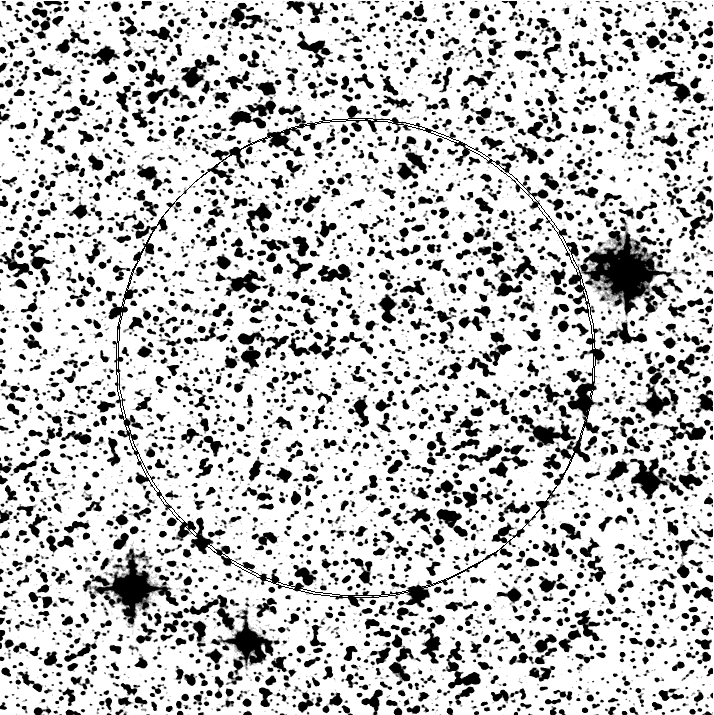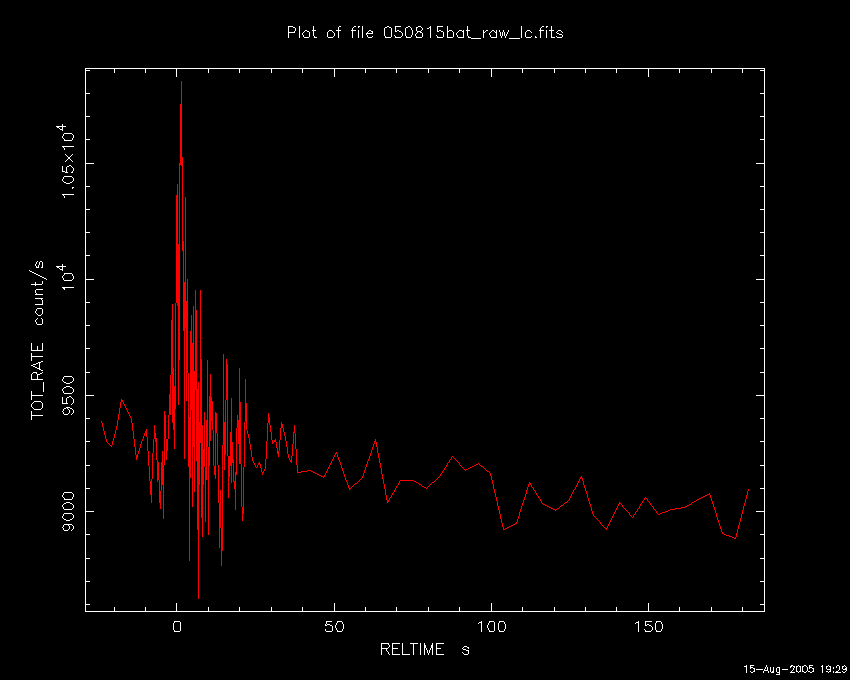- GCN/BACODINE POSITION NOTICE
TITLE: GCN/SWIFT NOTICE
NOTICE_DATE: Mon 15 Aug 05 17:25:48 UT
NOTICE_TYPE: Swift-BAT GRB Position
TRIGGER_NUM: 150532, Seg_Num: 0
GRB_RA: 293.575d {+19h 34m 18s} (J2000),
293.642d {+19h 34m 34s} (current),
292.975d {+19h 31m 54s} (1950)
GRB_DEC: +9.166d {+09d 09' 59"} (J2000),
+9.179d {+09d 10' 44"} (current),
+9.056d {+09d 03' 23"} (1950)
GRB_ERROR: 4.00 [arcmin radius, statistical only]
GRB_INTEN: 11036 [cnts] Image_Peak=370 [image_cnts]
TRIGGER_DUR: 2.048 [sec]
TRIGGER_INDEX: 262 E_range: 25-100 keV
BKG_INTEN: 113645 [cnts]
BKG_TIME: 62680.00 SOD {17:24:40.00} UT
BKG_DUR: 24 [sec]
GRB_DATE: 13597 TJD; 227 DOY; 05/08/15
GRB_TIME: 62718.72 SOD {17:25:18.72} UT
GRB_PHI: 31.71 [deg]
GRB_THETA: 8.21 [deg]
SOLN_STATUS: 0x3
RATE_SIGNIF: 12.60 [sigma]
IMAGE_SIGNIF: 8.78 [sigma]
MERIT_PARAMS: +1 +0 +0 +1 +2 +3 +0 +1 +77 +1
SUN_POSTN: 145.32d {+09h 41m 16s} +13.86d {+13d 51' 28"}
SUN_DIST: 141.03 [deg]
MOON_POSTN: 266.05d {+17h 44m 11s} -28.29d {-28d 17' 12"}
MOON_DIST: 45.99 [deg]
MOON_ILLUM: 78 [%]
GAL_COORDS: 46.02, -5.21 [deg] galactic lon,lat of the burst (or transient)
ECL_COORDS: 297.24, 30.40 [deg] ecliptic lon,lat of the burst (or transient)
COMMENTS: SWIFT-BAT GRB Coordinates.
COMMENTS: This is a rate trigger.
COMMENTS: A point_source was found.
COMMENTS: This does not match any source in the on-board catalog.
COMMENTS: This does not match any source in the ground catalog.
COMMENTS: This is a GRB.
- red DSS finding chart
ps-file

- GCN/SWIFT NOTICE
TITLE: GCN/SWIFT NOTICE
NOTICE_DATE: Mon 15 Aug 05 17:26:37 UT
NOTICE_TYPE: Swift-XRT Nack-Position
TRIGGER_NUM: 150532, Seg_Num: 0
POINT_RA: 293.582d {+19h 34m 20s} (J2000)
POINT_DEC: +9.165d {+09d 09' 56"} (J2000)
GRB_DATE: 13597 TJD; 227 DOY; 05/08/15
GRB_TIME: 62788.03 SOD {17:26:28.03} UT
COUNTS: 20 Min_needed= 20
STD_DEV: 42.48 Max_StdDev_for_Good=28.44 [arcsec]
PH2_ITER: 2 Max_iter_allowed= 4
ERROR_CODE: 3
COMMENTS: SWIFT-XRT Nack Position.
COMMENTS: Standard deviation too large.
- GCN/SWIFT NOTICE
TITLE: GCN/SWIFT NOTICE
NOTICE_DATE: Mon 15 Aug 05 17:29:06 UT
NOTICE_TYPE: Swift-BAT GRB Lightcurve
TRIGGER_NUM: 150532, Seg_Num: 0
GRB_RA: 293.575d {+19h 34m 18s} (J2000),
293.642d {+19h 34m 34s} (current),
292.975d {+19h 31m 54s} (1950)
GRB_DEC: +9.166d {+09d 09' 59"} (J2000),
+9.179d {+09d 10' 44"} (current),
+9.056d {+09d 03' 23"} (1950)
GRB_DATE: 13597 TJD; 227 DOY; 05/08/15
GRB_TIME: 62718.72 SOD {17:25:18.72} UT
TRIGGER_INDEX: 262
GRB_PHI: 31.71 [deg]
GRB_THETA: 8.21 [deg]
DELTA_TIME: 0.00 [sec]
TRIGGER_DUR: 2.048 [sec]
LC_URL: sw00150532000msb.lc
SUN_POSTN: 145.32d {+09h 41m 16s} +13.86d {+13d 51' 28"}
SUN_DIST: 141.03 [deg]
MOON_POSTN: 266.05d {+17h 44m 11s} -28.29d {-28d 17' 12"}
MOON_DIST: 45.99 [deg]
MOON_ILLUM: 78 [%]
GAL_COORDS: 46.02, -5.21 [deg] galactic lon,lat of the pointing direction
ECL_COORDS: 297.24, 30.40 [deg] ecliptic lon,lat of the pointing direction
COMMENTS: SWIFT-BAT GRB Lightcurve.
COMMENTS:
COMMENTS: The next comments were copied from the BAT_POS Notice:
COMMENTS: This is a rate trigger.
COMMENTS: A point_source was found.
COMMENTS: This does not match any source in the on-board catalog.
COMMENTS: This does not match any source in the ground catalog.
COMMENTS: This is a GRB.

- GCN notice #3811
D. Fox (PSU), L. Barbier (GSFC), S. Barthelmy (GSFC), D. Burrows
(PSU), J. Cummings (GSFC/NRC), N. Gehrels (GSFC), O. Godet
(U. Leceister), S.T. Holland (GSFC/USRA), S. Hunsberger (PSU),
J. Kennea (PSU), H. Krimm (GSFC/USRA), C. Markwardt (GSFC/UMD),
F. Marshall (GSFC), D. Morris (PSU), D. Palmer (LANL), K. Page
(U. Leicester), A. Parsons (GSFC), P. Roming (PSU), T. Sakamoto
(GSFC), P. Schady (PSU/UCL-MSSL), & E. Rol (Leceister) report on
behalf of the Swift team:
At 17:25:19 UT, Swift-BAT triggered and located GRB050815
(trigger=150532). The BAT on-board calculated location is RA,Dec
293.575d,+9.166d {19h 34m 18s,+09d 09' 59"}, with an uncertainty of 2
arcmin (radius, 90% containment, stat+sys). The BAT light curve shows
two peaks in 5 sec and possible low energy emission out to ~30 sec.
The peak count rate was ~1000 counts/sec (15-350 keV), at ~2 seconds
after the trigger.
The S/C slewed immediately and the XRT began taking data at 17:26:28,
70 s after the BAT trigger. The XRT on-board centroid algorithm did
not converge and no prompt position is available. However, the XRT
lightcurve shows evidence of a decaying source in the field of view.
We are waiting for down-linked data to determine a position.
The UVOT began observing the position of trigger #150532 at 17:26:25.5
UT, 67 s after the BAT trigger. In a 100 s V-band image, no new
source is detected with respect to the DSS down to a 5 sigma upper
limit of 18.1 mag. The estimated extinction in this direction is A_V
~ 1.6 magnitudes. The UVOT image gives 55% coverage of the BAT error
circle. The BAT source is located in a crowded star field.
- GCN notice #3812
D. C. Morris, D. N. Burrows, J. A. Kennea, J. L. Racusin (PSU), and N.
Gehrels (GSFC) report on behalf of the Swift XRT team:
The Swift BAT instrument detected GRB 050815 at 17:25:19 UT (Fox et al.
2005, GCN 3811). The observatory executed an automated slew to the BAT
position and the XRT began taking data at 17:26:28 UT (69 seconds after
the BAT trigger). Due to a low source count rate, the XRT did not succeed
in calculating an on-board centroid. In the ground-processed data, we
find a faint, uncataloged, fading X-ray source located at:
RA(J2000) = 19:34:22.9
Dec(J2000) = +09:08:46.1
We identify this as the afterglow of the GRB. We estimate an uncertainty
of about 8 arcseconds radius (90% containment). This source is located
102 arcseconds from the BAT position in GCN 3811.
- GCN notice #3813
Fang Yuan, E.S. Rykoff (U Mich) report on behalf of the ROTSE collaboration:
ROTSE-IIIc, located at the H.E.S.S. site at Mt. Gamsberg, Namibia,
responded to GRB 050815 (Swift trigger 150532), producing images
beginning 7.2 s after the GCN notice time. An automated response took
the first image at 17:25:54.2 UT, 35.5 s after the burst, under fair
conditions. We took 10 5-sec, 10 20-sec and 130 60-sec eposures. These
unfiltered images are calibrated relative to USNO A2.0 (R).
Comparison to the DSS (second epoch) reveals no new sources within the
3-sigma error circle, for both single images and coadding into sets of
10; however, we are limited as the field is severely crowded.
Furthermore, we do not detect any new objects in the XRT error circle
(Morris et al, GCN 3812). Individual images have limiting magnitudes
ranging from 14.9-15.8; we set the following specific limits.
start UT end UT t_exp(s) mlim t_start-tGRB(s) Coadd?
--------------------------------------------------------------------
17:25:54.2 17:25:59.2 5 14.9 35.5 N
17:25:54.2 17:27:25.2 91 15.8 35.5 Y
17:27:25.9 17:32:20.9 295 16.1 127.2 Y
- GCN notice #3814
D. Hullinger (GSFC/UMD), M. Ajello (MPE), L. Barbier (GSFC),
S. Barthelmy (GSFC), J. Cummings (GSFC/NRC), E. Fenimore (LANL),
R. Fink (GSFC), N. Gehrels (GSFC), H. Krimm (GSFC/USRA),
C. Markwardt (GSFC/UMD), D. Palmer (LANL), A. Parsons (GSFC),
T. Sakamoto (GSFC/NRC), G. Sato (ISAS), J. Tueller (GSFC)
on behalf of the Swift-BAT team:
Using the full data set from the recent telemetry downlink, we report
further analysis of Swift-BAT GRB 050815 (trigger #150532)
(Fox, et al., GCN 3811). The ground-analysis position is
RA,Dec 293.579,+9.145 (J2000) with an uncertainty of 2 arcmin
(radius, 90%, stat+sys). This is 59 arcsec from the XRT
refined position (Morris et al., GCN 3812). The light curve
shows an increase in emission starting at T-2 sec with a peak
at ~T+1 sec and the burst is over by T+4 sec. T90 is 2.8 +/-1 sec.
Fitting a simple power law over the interval from T-0.7 to T+2.4 sec,
the photon index is 1.8 +/- 0.2 with a fluence of
1.5 +/- 0.4 x 10^-7 erg/cm^2 in the 15-350 keV band (90% c.l.).
The peak flux in a 1-sec wide window starting at T-0.1 seconds
is 0.66 +/- 0.14 ph/cm^2/sec (15-350 keV). Based on the duration
of >2 sec and the soft spectrum, it does not appear that this burst
is in the short-hard category.
- GCN notice #3816
D. C. Morris, D. N. Burrows, J. A. Kennea, J. L. Racusin (PSU), and N.
Gehrels (GSFC) report on behalf of the Swift XRT team:
We have analysed the first three orbits of data for GRB050815 (GCN 3811,
Fox et al., 2005). Using xrtcentoid, the refined position is:
RA(J2000) = 19h 34m 23.2s
Dec(J2000) = +09d 08' 49.6"
with an uncertainty of 8 arcsec. This is 5.6 arcsec from the original
XRT position (GCN 3812, Morris et al., 2005).
The XRT began taking data at 17:26:28UT, 69 seconds after the BAT
trigger. The XRT collected data for only 123s during the first orbit
before the source was occulted. The data show a faint source in the
first orbit and suggest an initially shallow decay index of ~-0.2
followed by a break occuring somewhere between 192s and 3000s to a
steeper decay index of ~-2.1.
The spectrum is well fit (reduced chi-sq of 1.03 for 9 dof) by a power
law with neutral hydrogen consistent with the galactic column density of
2.7e21:
gamma=1.4 + / - 0.2
NH=2.1e21 + / - 7e20
Fixing the NH to the galactic column density also returns a good fit
(reduced chi-sq of 1.00 for 10 dof):
gamma=1.5 + / - 0.1
The count rate at 10000s after the trigger is ~0.015 cts/s which
converts to an unabsorbed flux of 9e-13 ergs cm^-2 s^-1 from 0.2-10keV.
- GCN notice #3817
P. Schady (MSSL/PSU), D. Fox (PSU), P. Roming (PSU), A. Cucchiara (PSU),
M. Still (GSFC), S.T. Holland (GSFC/USRA) K. Mason (MSSL), A. Blustin
(MSSL), N. Gehrels (GSFC), on behalf of the Swift UVOT team
The Swift Ultra-Violet Telescope (UVOT) began observations of GRB050815 on
August 15th, 2005 at 17:26:25.6 UT, 67s after the BAT trigger. The UVOT
took a 100s exposure in the V band and two 10s exposures in the M1 and W2
UV filters before the source was occulted by the Earth. The next set of
observations were made ~1hr after the BAT trigger.
Anylsis of the early time data reveals an uncatalogued source in the V
band at position
Ra, Dec = 19:34:23.147, +09:08:47.47
with an estimated uncertainty of 0.5". Astrometry was performed using
stars from the USNO-catalogue. The source is no longer detected in the
second epoch of V band images, confirming it's fading nature, and leading
us to conclude this to be the afterglow. No detections are made in any
other of the UVOT filters at the 3-sigma significance level.
Photometry carried out on this source requires additional care due to the
proximity ofvarious bright stars (~16-18mag). We estimate the afterglow to
have decayed by about 1 magnitude in 1 hour. Further analysis is still
undergoing.
- GCN notice #3822
P. B. Cameron (Caltech) and D. A. Frail (NRAO) report on behalf of a
larger collaboration:
"We have undertaken VLA observations at a frequency of 8.46 GHz toward
GRB 050815 (GCN 3814) on August 17.05 UT. No radio afterglow is
detected. At the position of the optical afterglow (GCN 3817) the
point-source limit is 77 +/- 45 microJy. No further observations are
planned.
The National Radio Astronomy Observatory is a facility of the National
Science Foundation operated under cooperative agreement by Associated
Universities, Inc."
- GCN notice #3862
D. Sharapov, G. Abdullaeva, M. Ibrahimov (MAO), A.Pozanenko (IKI),
V.Rumyantsev (CrAO) on behalf of larger GRB follow up collaboration report:
We observed the XRT error box (Morris et al, GCNs 3812,3816) of GRB050815
(Fox et al, GCN 3811) with 1.5m telescope of Maidanak Astronomical
Observatory. Set of R images were taken between (UT) 17:26 - 19:04, on
August 16.
We do not detect the OT (Schady et al, GCN 3817) in a stacked image.
Limiting magnitude of the stacked image (14x300 s) is R ~ 22.5. Detailed
photometry of the observation is underway.
The stacked image can be found in
http://grb.rssi.ru/GRB050815/grb050815_050816_AZT22_R.jpg
This message may be cited.

![]() Previous IAU Circulars
Previous IAU Circulars 

